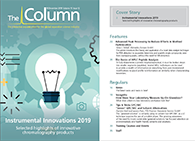Joel M. Harris Receives EAS Award
The Eastern Analytical Symposium (EAS) Award for Outstanding Achievements in the Fields of Analytical Chemistry was presented to Joel M. Harris at EAS 2019 on Wednesday 20 November.

The Eastern Analytical Symposium (EAS) Award for Outstanding Achievements in the Fields of Analytical Chemistry was presented to Joel M. Harris at EAS 2019 on Wednesday 20 November. Harris presented a plenary lecture, “Spectroscopy through the Microscope: Chemical Analysis at Liquid/Solid Interfaces” following the award.
Harris, a distinguished professor of chemistry at the University of Utah (Salt Lake City, Utah, USA), also holds an adjunct appointment in the Department of Bioengineering. He earned his Ph.D. from Purdue University (West Lafayette, Indiana, USA) and then joined the faculty of the University of Utah. His research has focused on analytical chemistry and spectroscopic studies of low concentrations of molecules in liquids and at liquid–solid interfaces. Along with his students, he has advanced new concepts in photothermal spectroscopy, methods to analyze multidimensional spectroscopic data, Raman spectroscopy of transient species and interfaces, and quantitative analysis of interfacial molecular populations by imaging and counting individual fluorescent molecules. He and his students have applied these methods to investigate the kinetics and energetics of excitedâstates and reactiveâintermediates, and molecular transport, adsorption, and binding kinetics that govern separations and analysis at liquid–solid interfaces.

HPLC 2025 Preview: Fundamentally Speaking (Part 2)
May 14th 2025Michael Lämmerhofer from the Institute of Pharmaceutical Sciences, University of Tübingen, Germany, spoke to JFK Huber Lecture Award winner of 2024 Torgny Fornstedt, professor in analytical chemistry and leader of the Fundamental Separation Science Group, Karlstad University, Sweden, about his pioneering work in high performance liquid chromatography (HPLC) with a focus on fundamentals, ion-pair chromatography, and oligonucleotide applications.

.png&w=3840&q=75)

.png&w=3840&q=75)



.png&w=3840&q=75)



.png&w=3840&q=75)












